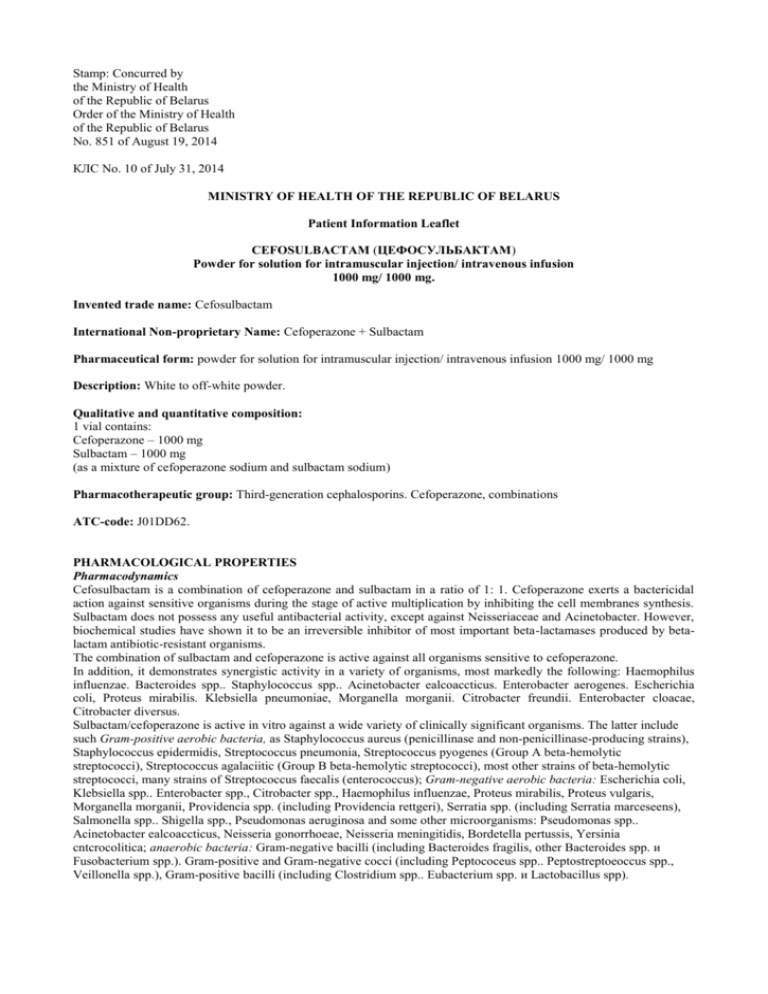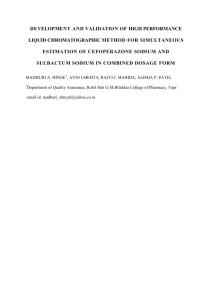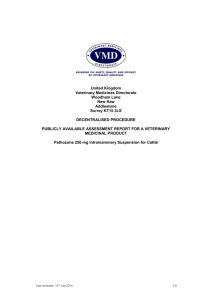Stamp: Concurred by the Ministry of Health of the Republic of
advertisement

Stamp: Concurred by the Ministry of Health of the Republic of Belarus Order of the Ministry of Health of the Republic of Belarus No. 851 of August 19, 2014 КЛС No. 10 of July 31, 2014 MINISTRY OF HEALTH OF THE REPUBLIC OF BELARUS Patient Information Leaflet CEFOSULBACTAM (ЦЕФОСУЛЬБАКТАМ) Powder for solution for intramuscular injection/ intravenous infusion 1000 mg/ 1000 mg. Invented trade name: Cefosulbactam International Non-proprietary Name: Cefoperazone + Sulbactam Pharmaceutical form: powder for solution for intramuscular injection/ intravenous infusion 1000 mg/ 1000 mg Description: White to off-white powder. Qualitative and quantitative composition: 1 vial contains: Cefoperazone – 1000 mg Sulbactam – 1000 mg (as a mixture of cefoperazone sodium and sulbactam sodium) Pharmacotherapeutic group: Third-generation cephalosporins. Cefoperazone, combinations ATC-code: J01DD62. PHARMACOLOGICAL PROPERTIES Pharmacodynamics Cefosulbactam is a combination of cefoperazone and sulbactam in a ratio of 1: 1. Cefoperazone exerts a bactericidal action against sensitive organisms during the stage of active multiplication by inhibiting the cell membranes synthesis. Sulbactam does not possess any useful antibacterial activity, except against Neisseriaceae and Acinetobacter. However, biochemical studies have shown it to be an irreversible inhibitor of most important beta-lactamases produced by betalactam antibiotic-resistant organisms. The combination of sulbactam and cefoperazone is active against all organisms sensitive to cefoperazone. In addition, it demonstrates synergistic activity in a variety of organisms, most markedly the following: Haemophilus influenzae. Bacteroides spp.. Staphylococcus spp.. Acinetobacter ealcoaccticus. Enterobacter aerogenes. Escherichia coli, Proteus mirabilis. Klebsiella pneumoniae, Morganella morganii. Citrobacter freundii. Enterobacter cloacae, Citrobacter diversus. Sulbactam/cefoperazone is active in vitro against a wide variety of clinically significant organisms. The latter include such Gram-positive aerobic bacteria, as Staphylococcus aureus (penicillinase and non-penicillinase-producing strains), Staphylococcus epidermidis, Streptococcus pneumonia, Streptococcus pyogenes (Group A beta-hemolytic streptococci), Streptococcus agalaciitic (Group B beta-hemolytic streptococci), most other strains of beta-hemolytic streptococci, many strains of Streptococcus faecalis (enterococcus); Gram-negative aerobic bacteria: Escherichia coli, Klebsiella spp.. Enterobacter spp., Citrobacter spp., Haemophilus influenzae, Proteus mirabilis, Proteus vulgaris, Morganella morganii, Providencia spp. (including Providencia rettgeri), Serratia spp. (including Serratia marceseens), Salmonella spp.. Shigella spp., Pseudomonas aeruginosa and some other microorganisms: Pseudomonas spp.. Acinetobacter ealcoaccticus, Neisseria gonorrhoeae, Neisseria meningitidis, Bordetella pertussis, Yersinia cntcrocolitica; anaerobic bacteria: Gram-negative bacilli (including Bacteroides fragilis, other Bacteroides spp. и Fusobacterium spp.). Gram-positive and Gram-negative cocci (including Peptococeus spp.. Peptostreptoeoccus spp., Veillonella spp.), Gram-positive bacilli (including Clostridium spp.. Eubacterium spp. и Lactobacillus spp). Stamp: Concurred by the Ministry of Health of the Republic of Belarus Order of the Ministry of Health of the Republic of Belarus Pharmacokinetics Absorption Mean peak sulbactam and cefoperazone concentrations after the administration of 1000 mg /1000 mg intravenously over 5 minutes were 130.2 and 236.8 mcg/ml respectively. Distribution Both sulbactam and cefoperazone distribute well into a variety of tissues and fluids including bile, gall bladder, skin and soft tissue, appendix, peritoneum, ovary, uterus, and others. The larger volume of distribution was observed for sulbactam (18.0-27.6 l) compared to cefoperazone (10.2-11.3 l). Serum concentrations have been shown to be proportional to the dose administered. There is no evidence of any pharmacokinetic drug interaction between sulbactam and cefoperazone when administered together in the form of sulbactam/cefoperazone. After multiple dosing no significant changes in the pharmacokinetics of either component of sulbactam/cefoperazone have been reported and no accumulation has been observed when administered every 8 to 12 hours. Cefoperazone does not displace bilirubin from plasma protein binding sites. Metabolism and elimination Approximately 84% of the sulbactam dose and 25% of the cefoperazone dose administered with sulbactam/cefoperazone is excreted by the kidney. Most of the remaining dose of cefoperazone is excreted in the bile. After sulbactam/cefoperazone administration the mean half-life for sulbactam is about 1 hour while that for cefoperazone is 1.7 hours. Pharmacokinetics in special populations The serum half-life of cefoperazone is usually prolonged and urinary excretion of the drug increased in patients with hepatic diseases and/or biliary obstruction. Even with severe hepatic dysfunction, therapeutic concentrations of cefoperazone are obtained in bile and only a 2- to 4-fold increase in half-life is seen. In patients with different degrees of renal dysfunction administered sulbactam/cefoperazone, the total body clearance of sulbactam was highly correlated with estimated creatinine clearance. Patients who are functionally anephric showed a significantly longer half-life of sulbactam (mean 6.9 and 9.7 hours in separate studies). Hemodialysis significantly altered the half-life, total body clearance, and volume of distribution of sulbactam. No significant differences have been observed in the pharmacokinetics of cefoperazone in renal failure patients. The pharmacokinetics of sulbactam/cefoperazone have been studied in elderly individuals with renal insufficiency and compromised hepatic function. Both sulbactam and cefoperazone exhibited longer half-life, lower clearance, and larger volumes of distribution when compared to data from normal volunteers. The pharmacokinetics of sulbactam correlated well with the degree of renal dysfunction while for cefoperazone there was a good correlation with the degree of hepatic dysfunction. Studies conducted in pediatrics have shown no significant changes in the pharmacokinetics of the components of sulbactam/cefoperazone compared to adult values. The mean half-life in children has ranged from 0.91 to 1.42 hours for sulbactam and from 1.44 to 1.88 hours for cefoperazone. Therapeutic indications Monotherapy Sulbactam/cefoperazone is indicated for the treatment of the following infections when caused by susceptible organisms: - Respiratory tract infections (upper and lower): Streptococcus pneumoniae, Haemophilus influenzae. Staphylococcus aureus (penicillinase and non-penicillinase-producing strains), Streptococcus pyogenes (Group A). Pscudomonas aeruginosa. Klebsiella pneumoniae. Escherichia coli, Proteus mirabilis. Enterobacter spp.; - Urinary tract infections (upper and lower): Eschcrichia coli, Pscudomonas aeruginosa, Proteus mirabilis; - Peritonitis, cholecystitis, cholangitis and other intra-abdominal infections: Escherichia coli, Pscudomonas aeruginosa and anaerobic Gram-negative bacteria (including Bacteroides fragilis). Streptococcus spp., Pscudomonas spp., Enterobactcriaceae: - Sepsis: Streptococcus pneumonia. Streptococcus agalactiae. Staphylococcus aureus, Pseudomonas aeruginosa; - Skin and soft tissue infections: Staphylococcus aureus, Streptococcus pyogenes, Pseudomonas aeruginosa; - Pelvic inflammatory disease, endometritis, gonorrhea, and other infections of the genital tract: Neisseria gonorrhocae. Staphylococcus epidermidis, Streptococcus agalactiae, Escherichia coli, anaerobic microorganisms, including Bacteroides fragilis. Stamp: Concurred by the Ministry of Health of the Republic of Belarus Order of the Ministry of Health of the Republic of Belarus Combination therapy Because of the broad spectrum of activity of sulbactam/cefoperazone, most infections can be treated adequately with this antibiotic alone. However, sulbactam/cefoperazone may be used concomitantly with other antibiotics if such combinations are indicated. If an aminoglycoside is used, renal function should be monitored during the course of therapy. Contraindications Hypersensitivity to penicillins, sulbactam, cefoperazone and other cephalosporins. Special warnings and precautions for use Use in pregnancy and lactation Cefoperazone and sulbactam cross the placental barrier. Cefosulbactam should not be used during pregnancy and lactation except when the potential benefit justifies the potential risk. In each case, the drug must be used under the direct supervision of a physician. Special warnings Serious and occasionally fatal hypersensitivity (anaphylactic) reactions have been reported in patients receiving betalactam or cephalosporin therapy. These reactions are more apt to occur in individuals with a history of hypersensitivity reactions. If an allergic reaction occurs, the drug should be discontinued and the appropriate therapy instituted. Serious anaphylactic reactions require immediate emergency treatment with epinephrine. Oxygen, intravenous steroids, and airway management, including intubation, should be administered as indicated. Dose modification may be necessary in cases of severe biliary obstruction, severe hepatic disease or in cases of renal dysfunction coexistent with either of those conditions. In patients with hepatic dysfunction and concomitant renal impairment, cefoperazone serum concentrations should be monitored and dosage adjusted as necessary. Without close monitoring of serum concentrations, the dosage should not exceed 2 g/day of cefoperazone As with other antibiotics, Vitamin K deficiency has occurred in a few patients treated with Cefosulbactam. Those at risk include patients with poor diet, malabsorption states (e.g., cystic fibrosis) and patients on prolonged intravenous alimentation regimens. Prothrombin time should be monitored in these patients, and patients receiving anticoagulant therapy, and exogenous vitamin K administered as indicated. As with other antibiotics, overgrowth of non-susceptible organisms may occur during prolonged use of sulbactam/cefoperazone. Patients should be observed carefully during treatment. As with any potent systemic agent, it is advisable to check periodically for organ system dysfunction during extended therapy; this includes renal, hepatic, and hematopoietic systems. This is particularly important in neonates, especially when premature, and other infants. A reaction characterized by flushing, sweating, headache, and tachycardia has been reported when alcohol was ingested during and as late as the fifth day after cefoperazone/ sulbactam administration. For patients requiring artificial feeding orally or parenterally, solutions containing ethanol should be avoided. Clostridium difficile associated diarrhea (CDAD) has been reported with use of nearly all antibacterial agents, including cefoperazone, and may range in severity from mild diarrhea to fatal colitis. Treatment with antibacterial agents alters the normal flora of the colon leading to overgrowth of C. difficile. C. difficile produces toxins A and B which contribute to the development of CDAD. Hypertoxin producing strains of C. difficile cause increased morbidity and mortality, as these infections can be refractory to antimicrobial therapy and may require colectomy. CDAD must be considered in all patients who present with diarrhea following antibiotic use. Careful medical history is necessary since CDAD has been reported to occur over two months after the administration of antibacterial agents. A false-positive reaction for glucose in the urine may occur with Benedict's or Fehling's solution during the laboratory investigations. Stamp: Concurred by the Ministry of Health of the Republic of Belarus Order of the Ministry of Health of the Republic of Belarus Posology and method of administration The drug is administered intramuscularly and intravenously (by bolus injection or infusion). The dosing schedule and the route of administration should be determined depending on the susceptibility of the causative organisms, the severity of the infection, and the renal function of the patient. Before using the drug product, perform a skin tolerance test. Use in adults Standard dose of Cefosulbactam in adults is 2 to 4 g (i.e. 1 to 2 g of cefoperazone activity) given by intravenous or intramuscular administration. Doses should be administered every 12 hours in equally divided doses. Ratio 1:1 Cefoperazone /Sulbactam (g) 2-4 Cefoperazone dose (g) 1-2 Sulbactam dose (g) 1-2 In severe or refractory infections the daily dosage of sulbactam/cefoperazone may be increased up to 8 g intravenously (i.e., 4 g cefoperazone activity). Doses should be administered every 12 hours in equally divided doses. The recommended maximum daily dosage of sulbactam is 4 g (8 g of Cefosulbactam). Use in impaired hepatic function. Dose modification may be necessary in cases of severe biliary obstruction, severe hepatic disease or in cases of renal dysfunction coexistent with either of those conditions. In patients with hepatic dysfunction and concomitant renal impairment, cefoperazone serum concentrations should be monitored and dosage adjusted as necessary. In these cases dosage should not exceed 2 g/day of cefoperazone without close monitoring of serum concentrations. Use in impaired renal function. Dosage regimens of sulbactam/cefoperazone should be adjusted in patients with marked decrease in renal function (creatinine clearance of less than 30 ml/min) to compensate for the reduced clearance of sulbactam. Patients with creatinine clearances between 15 and 30 ml/min should receive a maximum of 1 g of sulbactam administered every 12 hours (maximum daily dosage of 2 g sulbactam), while patients with creatinine clearances of less than 15 ml/min should receive a maximum of 500 mg of sulbactam every 12 hours (maximum daily dosage of 1 g sulbactam). In severe infections it may be necessary to administer additional cefoperazone. The pharmacokinetic profile of sulbactam is significantly altered by hemodialysis. The serum half-life of cefoperazone is reduced slightly during hemodialysis. Thus, dosing should be scheduled to follow a dialysis period. Geriatric use In geriatric patients both sulbactam and cefoperazone exhibited longer half-life, lower clearance, and larger volumes of distribution. The pharmacokinetics of sulbactam correlated well with the degree of renal dysfunction while for cefoperazone there was a good correlation with the degree of hepatic dysfunction. Pediatric use Standard pediatric dose of Cefosulbactam is 40-80 mg/kg/day (i.e. 20-40 mg/kg cefoperazone). Doses should be administered in two to four equally divided doses. Ratio 1:1 Cefoperazone /Sulbactam (g) (mg/kg/day) 40-80 Cefoperazone dose (g) (mg/kg/day) 20-40 Sulbactam dose (g) (mg/kg/day) 20-40 Use in neonates. For neonates in the first week of life, the drug should be given every 12 hours. The maximum daily dosage of sulbactam in pediatrics should not exceed 80 mg/kg/day. If more than 80 mg/kg/day of cefoperazone activity are necessary, additional cefoperazone should be administered separately. Stamp: Concurred by the Ministry of Health of the Republic of Belarus Order of the Ministry of Health of the Republic of Belarus Instructions for preparation and administration of the solution To prepare the solution for intravenous bolus injection, the contents of the vial of Cefosulbactam (1,000 mg / 1,000 mg) is dissolved in 20 ml of one of the following solvents: 0.9% sodium chloride, 5% glucose solution in water, 5% glucose solution in 0.9 % sodium chloride solution. The resulting solution is agitated until complete dissolution of the powder. Intravenous bolus injection is performed slowly over 3-5 minutes. To prepare the solution for intravenous infusion, the contents of the vial of Cefosulbactam (1,000 mg / 1,000 mg) is dissolved in 10 ml of one of the following infusion solutions: 0.9% sodium chloride, 5% glucose solution in water, 5% glucose solution in 0.9 % sodium chloride solution. The resulting solution is agitated until complete dissolution of the powder and diluted with lactated Ringer's solution to a sulbactam concentration of 5 mg / ml (10 ml of the resulting solution is diluted in 200 ml of Lactated Ringer's solution). Initial reconstitution with lactated Ringer's solution should be avoided, since this mixture has been shown to be incompatible! Intravenous infusion is performed slowly over 15-60 minutes. To prepare the solution for intramuscular injection, the contents of the vial of Cefosulbactam (1,000 mg / 1,000 mg) is dissolved in 5 ml of water for injections. The resulting solution is agitated until complete dissolution of the powder. Then 2 ml of 2% lidocaine hydrochloride solution is added. After stirring, the solution is injected deep into the muscle in the areas of the body with pronounced muscle layer (for example, the upper-outer quadrant of the buttocks). Initial reconstitution with lidocaine hydrochloride solution should be avoided, since this mixture has been shown to be incompatible! The drug solution containing lidocaine should not be used intravenously! Standard aseptic techniques should be used for solution preparation and administration. Prepare the solution immediately before use. To avoid the administration of the dose that is less than the required one, the drug should be completely dissolved. The prepared solution should be carefully removed from the vial! Undesirable effects Sulbactam/cefoperazone is generally well tolerated. The majority of adverse events are of mild or moderate severity and are tolerated with continued treatment. Allergic reactions: anaphylactic shock, maculopapular rash, pruritus, urticaria, Stevens-Johnson syndrome. These reactions are more likely to occur in patients with a history of allergies. Gastrointestinal disorders: diarrhea, nausea, vomiting, pseudomembranous colitis. Investigations: Transient elevations of liver function tests – aspartate aminotransferase (ACT), alanine aminotransferase (ALT). alkaline phosphatase (ALP), serum bilirubin. Blood and lymphatic system disorders: decreases in neutrophils; reversible neutropenia may occur with prolonged administration. Decreased hemoglobin or hematocrit has been reported, transient eosinophilia, leukopenia, thrombocytopenia, hypoprothrombinemia; in some cases – a positive Coombs test. Renal and urinary disorders: hematuria. Local reactions: Sulbactam/cefoperazone is well tolerated following intramuscular administration. Occasionally, transient pain an burning sensation at the injection site may follow administration by this route. As with other cephalosporins and penicillins, when sulbactam/cefoperazone is administered by an intravenous catheter some patients may develop phlebitis at the infusion site. Other: headache, fever, chills, vasculitis. Overdose Limited information is available on the acute toxicity of cefoperazone sodium and sulbactam sodium in humans. Overdose of the drug would be expected to produce manifestations that are principally extensions of the adverse reactions reported with the drug. The fact that high concentrations of beta -lactam antibiotics in cerebrospinal fluid may cause neurologic effects, including seizures, should be considered. Treatment: symptomatic, hemodialysis is effective, especially if overdose occurs in patients with impaired renal function. Stamp: Concurred by the Ministry of Health of the Republic of Belarus Order of the Ministry of Health of the Republic of Belarus Interaction with other medicinal products and other forms of interaction Solutions of sulbactam/cefoperazone and aminoglycosides should not be directly mixed, since there is a physical incompatibility between them. If combination therapy with sulbactam/cefoperazone and an aminoglycoside is contemplated, this can be accomplished by sequential intermittent intravenous infusion provided that separate secondary intravenous tubing is used, and that the primary intravenous tubing is adequately irrigated with an approved diluent between doses. It is also suggested that doses of sulbactam/cefoperazone be administered throughout the day at times as far removed from administration of the aminoglycoside as possible. The concomitant use of cefoperazone / sulbactam with anticoagulants and antiplatelet agents increases the risk of bleeding, particularly gastrointestinal one. The concomitant use with thrombolytics should be avoided. Storage conditions and shelf-life Store in a dry and dark place at the temperature not above 25°C. Keep out of reach of the children. 2 years. Do not use beyond the labeled expiration date. Prescription status Prescription only medicine. Presentation 1000 mg / 1000 mg in a 20 ml vial. 5 vials in a pack or 25 vials in a box (for inpatient facilities). Manufacturing company TriplePharm JLLC, Minskaya str., 2B, 223141, Logoysk, Republic of Belarus, telephone /fax: (+375) 1774 43 181, email: triplepharm@gmail.com.









